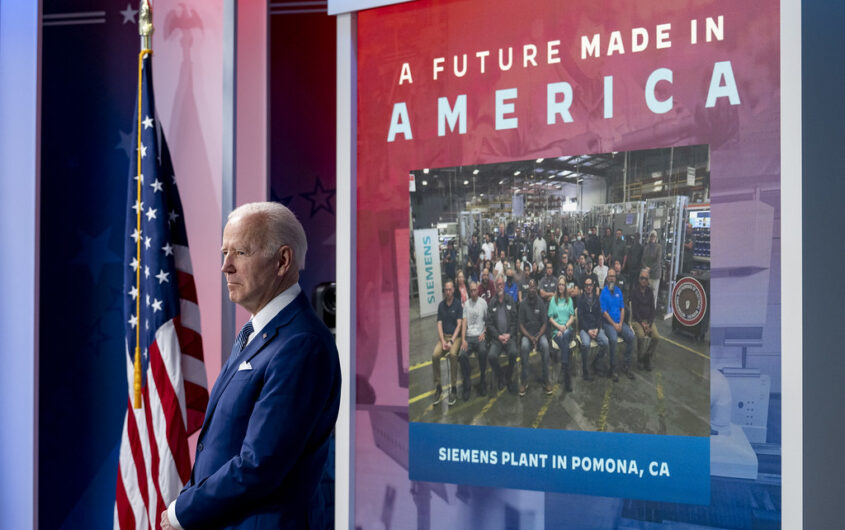
The White House via Flickr
Industrial Policy: The New défi américain

Stephen Silvia
American University
Dr. Stephen Silvia is a Geoeconomics Non-Resident Senior Fellow at AICGS. He is a Professor of Economics in the School of International Service at American University, where he teaches international economics, international relations and comparative politics. He researches comparative labor employment relations, and comparative economic policy, with a focus on Germany and the United States.
The Biden Administration’s unapologetic embrace of a nationalistic industrial policy a year ago with the passage of the Creating Helpful Incentives to Produce Semiconductors (CHIPS) and Inflation Reduction Acts (IRA) caught Germans in both the private and public sectors off guard and put them in a difficult spot. Many in Europe hoped that the election of Joe Biden meant that the United States would revert to a traditional preference for market liberalization after Donald Trump’s disruptive “America first” trade measures. Some of the new administration’s actions suggested as much; it reached an agreement with the European Union that effectively ended Trump’s quotas on aluminum and steel imports and resolved the long-running Airbus-Boeing dispute. A return to the status quo ante did not continue for three reasons, however.
First, championing blue-collar workers and reinvigorating domestic manufacturing are core objectives for Biden and central to his reelection strategy. Indeed, on the campaign trail, Biden promised not to make any new free trade agreements and to strengthen “buy American” provisions for government procurement. Second, the COVID-19 pandemic, increased frictions with China, and Russia’s war of aggression against Ukraine elevated the importance of economic resiliency and national security over efficiency and the lowest price. Third, Biden promised to combat climate change, but the administration was determined to steer clear of the vinegar-laden policies that economists typically recommend as most effective and efficient—namely, a carbon tax and higher energy prices—to avoid a business and blue-collar backlash. He instead offered the honey of substantial subsidies to spur investment that would not only limit global warming but also create domestic manufacturing jobs. To the surprise and dismay of many Europeans, CHIPS, the IRA, and infrastructure legislation all included “buy American” and North American content provisions. When challenged about this, Biden administration officials routinely reply that the United States is finally fighting climate change as Europeans had long demanded; they should not now complain about the particulars. They also suggest that Europeans should instead adopt similar measures.
The German government has not yet decided whether it would be better to fight or to copy the United States. German policymakers at the federal level traditionally prefer market liberalization and curtailing subsidies. They also do not want to undercut decades of progress toward containing subsidies in the European Union, but context complicates matters. Germany has slipped to the bottom of the table when it comes to economic growth owing to chronic private and public underinvestment, an aging population, complacency regarding economic and regulatory policy that began during Angela Merkel’s chancellorship, events abroad that have hit the Federal Republic particularly hard (i.e., the war in Ukraine and economic uncertainty in China), and recent missteps by Olaf Scholz’s government in formulating climate protection legislation.
Meeting the new U.S. challenge by returning to Germany’s foundational postwar economic principles rather than copying America is the most promising route to restore the German economy.
How should German policymakers respond to this new défi américain? They have three choices: (1) maintain the status quo, (2) follow the American lead and embrace industrial policy that discriminates at the national and European levels, or (3) adopt often politically difficult measures to invigorate the economy that do not increase segmentation and inefficiency.
Although few would consciously choose the first option, Germany may end up with it by default. Decision-making regarding the economy in Germany’s current three-party coalition has often proved as difficult as critics had feared it would be. Chancellor Scholz has not taken the lead in economic affairs the way his Social Democratic predecessor Gerhard Schröder did, and the government has not developed a comprehensive economic policy. Scholz has instead parceled out the lead on discrete economic policy areas to cabinet ministers from the three coalition parties. Predictably, the three parties have struggled to reach common positions.
A tempting alternative would be to follow the United States’ lead and embrace industrial policy. Proponents argue that it would jumpstart public and private investment, accelerate efforts to curb climate change, and shore up employment in manufacturing. So far, German government policy has been incoherent. On the one hand, federal and state governments have set aside 15 billion euros to subsidize U.S. and Taiwanese companies to construct chip “fabs.” On the other hand, it has begun to reduce subsidies for the purchase of electric vehicles. Caution is warranted. Peterson Institute president Adam Posen argues that Bidenomics, “while having considerable popular appeal at home, is based on four profound analytic fallacies: that self-dealing is smart; that self-sufficiency is attainable; that more subsidies are better; and that local production is what matters. Each of these assumptions is contradicted by more than two centuries of well-researched history of foreign economic policies and their effects.” As New York Times columnist David Brooks notes regarding China, “Industrial policy may look good for a short time, but it ossifies.” This is no less true for Germany and Europe. For example, sectors with high fixed costs such as computer chip production have substantial economies of scale. If every country makes chips, the cost of making them will go up and oversupply will drive down prices. Producers will remain unprofitable, and governments will be left with a large tab but few jobs.
What should German policymakers do instead? First, they should work within the European Union. Such an approach is difficult because it takes longer and often yields less, but it would preserve at least some scale economies. Second, they should only focus on framework conditions (Rahmenbedingungen) that promote growth, in keeping with the German tradition of ordo-liberalism, rather than subsidizing individual sectors. This means investing in basic research and infrastructure to increase innovation and productivity, which are the foundations of growth in output and wages. This should include deficit spending when the results warrant it. Third, they should identify a narrow set of products that truly require support for reasons of climate and national security. Fourth, they should pare back regulations that inhibit business formation and building green infrastructure.
Such reforms can be politically difficult. Jean Claude Juncker’s famous remark from two decades ago still holds: “We all know what to do, but we don’t know how to get re-elected once we have done it.” That said, meeting the new U.S. challenge by returning to Germany’s foundational postwar economic principles rather than copying America is the most promising route to restore the German economy.









